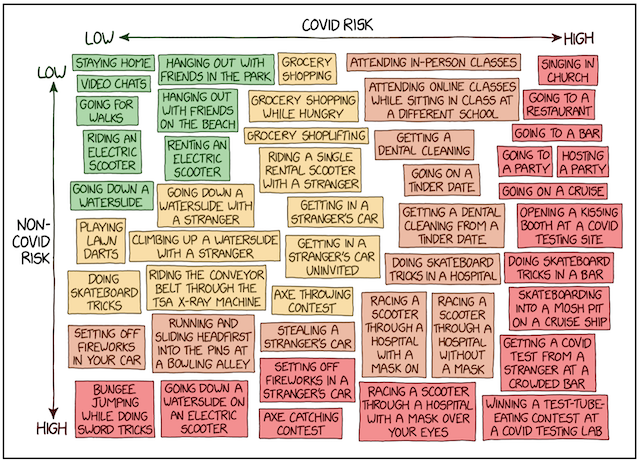
cartoon by the late Dana Fradon, in The New Yorker, way back in 1976
One of the signs of social collapse is, ironically, the simultaneous emergence of autocratic demagogues and a soaring distrust of perceived ‘leaders’ of all kinds — politicians, CEOs, priests, the mainstream media hegemony, the social media oligopoly, and ‘experts’ in every field. What we’re seeing in many countries now is a complete power vacuum as so-called world leaders whine and yell on social media like spoiled children instead of actually doing anything to improve the lot of citizens struggling with an increasingly desperate and teetering culture. This has the value of rather baldly showing us that no one is really in control, and that if we want things done we’ll have to self-organize and do them ourselves. My sense is that this self-organization in a power vacuum will be a hallmark of the coming decades, and I’ll be writing about it further soon. There couldn’t be a stronger symbolic demonstration of this shift than the large-scale toppling of statues of historical ‘leaders’ who are now seen not as heroes but as symptoms of a systemic and still-present disease that must now, urgently, be abolished — not by new ‘leaders’ but by all of us in self-organizing communities. (Thanks to Alberta Pedroja for the prompt.)
CIVILIZATION’S COLLAPSE

Cartoon by Michael Leunig
Partying like it’s 2099: David Wallace-Wells explains that arctic temperatures have already reached levels not expected to be reached until 2099, the odds of limiting global average temperature rise to the 2.0ºC limit suggested as “inadequate to prevent runaway climate change” have now dropped to 0.3%, and in some places once-in-500-year extraordinary weather events have now occurred five years in a row. While our attention has been focused elsewhere, runaway climate change has, apparently, already begun.
Next up for our short attention spans: And so we whipsaw our attention from climate collapse to social justice to systemic racism to systemic corruption to systemic misogyny to economic precarity, and then back to pandemics. None of these problems is being addressed, none of them is improving, and all of them are out of control. The salvationists continue to proclaim that we can be saved, by technology, by a wise or hard-nosed elite, by faith, by diligent preparation, or (always the loudest proclamation) by a collective upraising of human consciousness. Ever-hopeful, we humans. Even as, fed by the happiness-promising industrial agricultural machine, we anxiously eat ourselves to death.
LIVING BETTER

from xkcd, of course
Why racist violence shouldn’t surprise us: Waleed Aly’s moving, eye-opening response to last year’s Christchurch massacre. Even more eye-opening is the torrent of racist responses in the comments.
The difficulty of explaining complex predicaments: Hank Green brilliantly explains why, despite the enormous success and value of the Vlogbrothers’ Explainer video series, they’ve stopped making them because they realize they can’t prevent their own biases from creeping in.
Feminism and CoVid-19: Hawaii’s State Commission on the Status of Women has drafted a feminist recovery plan for the state, including a guaranteed annual income. Hope the politicians implement it. Thanks to Tree Bressen for the link.
Seventeen things that are quite good: The list (it’s an open-edit Google Doc) originated by Vinay Gupta is now 30 items, with discussion. I don’t agree with all of them, but the discussion is great and you’re sure to learn something useful.
POLITICS & ECONOMICS AS USUAL

Facebook meme, original source unknown; thanks to Cheryl Long for the link
Just call it White Supremacy: Charles Blow on the language of oppression. “The lulls you experience between explosive revolts of the oppressed should never be mistaken as harmony. They should be taken as rest breaks.” Thanks to Tree Bressen for the link.
Donald Trump, fascist and shiller of beans: Masha Gessen lists the ways in which the shithole president’s behaviour represents unbridled fascism, autocracy, corruption, and abuse of power, and has since his days as a failed real estate speculator. And when he’s not doing that, he’s shilling beans.
Misinformation watch:
-
- A war vet rips holes in the preposterous CIA story of Russia offering money to the Taliban to kill Americans (thanks to Lorraine Suzuki for the link)
- Upworthy debunks the fiction of “Irish slaves” being used by right-wingers to downplay America’s history of racism and oppression of Blacks
- The New Yorker describes a research study that obliterates the anti-abortion myths that women who have abortions later regret it, and that abortions are dangerous
Rogue cops in Oregon (thanks to Tree Bressen for the links):
-
- Un-uniformed and unwanted federal cops kidnap and terrorize Portland’s citizens: This appears to be Trump’s attempt to goad the city’s protesters into violence. The state has sued the feds, and the city has demanded their removal.
- A federal judge has blocked Portland police from interfering with journalists and legal observers covering the protests.
- Brady lists of the state’s rotten, expelled cops are a start, but aren’t being consistently maintained.
Latest Canadian awfulness:
-
- Ontario introduces its Ag-Gag law: The political protection of institutionalized extreme cruelty to animals for profit continues unabated.
- Alberta government employed a racist video producer as judicial selection panelist, and still employs a racist media columnist as the premier’s speechwriter.
- The University of BC has a long history of coddling and providing a speaking platform for right-wing hate-mongers and racists.
An apology to JK Rowling: The vicious attacks on JK Rowling for her expressed concern that the project of feminism and the needs of WBW are being trampled by an ideological fringe of “identitarian leftists” have been relentless. One writer eloquently apologizes. And now an open letter warning of a larger trend among leftists to ideological closed-mindedness and inflexibility has been likewise assailed for not spouting the rigid leftist party line. A few weeks earlier, satirist Jonathan Pie ripped into this same rigidity in “Woke” culture. We’ve got to stop taking our anger out on each other and redirect it to our common nemeses.
Has Biden been radicalized by CoVid-19 and BLM?: David Wallace-Wells in conversation with Washington governor Jay Inslee, whose climate emergency plan has just been adopted by Biden. Posturing, or shifting ground?
Prisons: Our new privatized, dysfunctional, expensive mental institutions: “In the U.S., people with serious mental illnesses are far more likely to be incarcerated than they are to be treated in a psychiatric hospital — despite the fact that incarceration often makes mentally ill people worse… [And] the foremost thing that I saw over and over again is how much we want people to suffer once they’re held within our jails and prisons.”
COVID-19 CORNER

“one of these things is not like the others ♫ …” — can you guess what’s going to happen NEXT? — nope, sorry, wrong guess! (the correct answer is — no) — (charts from Atlantic Magazine’s CoVid Tracking Project)
…” — can you guess what’s going to happen NEXT? — nope, sorry, wrong guess! (the correct answer is — no) — (charts from Atlantic Magazine’s CoVid Tracking Project)
Lies and statistics:
-
- CoVid-19 infections and deaths: the unofficial story: Officially, the US has reported just under 150,000 CoVid-19 deaths and just under four million infections. But statistical “excess deaths” data indicates that, like just about everywhere else, deaths have been undercounted by a third, meaning the actual US death toll so far has streaked past 200,000. On that basis, working backwards from deaths to infections, it is likely that at least 17 million and as many as 20 million Americans have caught the disease. A total of 350,000 deaths and 35 million cases (about 10% of the population; nowhere near “herd immunity”) will likely have occurred by November.
- The positive result rate on US tests has risen recently to about 8%, far above the level at which infections could be said to be under control, as they are in jurisdictions with well-established test, contact trace and isolation procedures.
- Canada likewise has “excess deaths” numbers that suggest deaths have been undercounted by a third or more. But the fatality rate suggests that a much smaller proportion of Canadians (about 13,000) have died, and fewer than a million have been infected. A total of about 17,000 deaths and 1.7 million cases (about 4.5% of the population) will likely have occurred by November.
- The positive result rate on Canadian tests has remained remarkably low — less than 1%, despite the fact Canada has been doing about 1/3 fewer tests on a per capita basis; this suggests that, at least for now, it’s under control. IHME suggests that will change when new cases spike in the fall in at least two provinces (BC & Québec), even if the border with the US remains closed.
- The Atlantic explores how a younger average demographic now testing positive could mean lower hospitalization rates (though that has not yet been the case), and lower death rates. IFRs are as much as two orders of magnitude lower among those under 30 as for those over 60. But we still don’t know how this virus affects us, including long-term organ damage even among those asymptomatic, that could create health crises emerging much later on a much larger scale than the virus infections themselves.
Let’s not forget the cause: Zoonotic transmission of pandemic viruses is directly related to deforestation, habitat loss, and incursion of humans into previously unsettled areas.
Lessons from the Manchurian plague: This 1910 bacterial pneumonic plague cost 60,000 lives, and what we learned from international cooperation to study and end it (including the first use of masks as disease spread preventative) prevented even greater loss of life in the 1918 influenza, and paved the way for much that we do to combat pandemics today. Thanks to Davis Andrews for the link.
The Mask Controversy:
-
- There’s a nasty squabble going on about whether the virus is spread by small aerosol particle transmission, not just droplets (mostly liquid in coughs and sneezes). It has major repercussions for the effectiveness of masks. BC’s health leader Bonnie Henry says the dispute is overblown and masks are warranted despite some limitations in their effectiveness, and masks should always be used in conjunction with other measures.
- Meanwhile in the US, Anthony Fauci has been excommunicated and is being undermined by Der Drumpf. Dr F is now speaking directly to the public through the media. The message is the same: masks whenever in public, whenever 6′ social distancing is difficult, and certainly whenever indoors away from home.
- Here’s a guide to which masks are best.
- And here’s what might happen if you don’t wear them.
FUN & INSPIRATION

electron microscope photograph of an ant, source not cited, from Earth FB page; commenter’s response: “looks like a purple Joe Biden”
You’ll never shine if you don’t glow: A lovely little video essay on fireflies and vulnerability from John Green.
Our home on Native land: The title is a take-off on the line “our home and native land” in Canada’s national anthem. The site shows all the indigenous territories Europeans have occupied throughout the world (Brasil is notably missing), and their languages. Thanks to Tree Bressen for the link.
Sy Hersh comes out of seclusion: The eccentric, much-celebrated investigative journalist has broken a long silence since Trump was elected to answer, kind of, the question why he hasn’t been re-energized by the corruption of the Trump regime. Fascinating reading. Thanks to John Whiting for the prompt.
Shari Ulrich’s homage to Canada: The renowned singer, composer and multi-instrumentalist jams with a bunch of my other neighbours in a delightful song she wrote about her adopted home here in BC. And if you’ve ever lost someone to Alzheimers, you’ll probably like her lovely new song The Sweater.
The NYT Manual of Style: There’s a ‘preview’ version of the first 130 pages (words starting with A-F) of this classic 350-page reference. If you’re a word and writing style geek like me, you’ll probably find it fascinating reading. The contrast in styles to the (free) 25-page Oxford style guide is telling.
Indigenous Americans had contact with Polynesians 800 years ago: New DNA research indicates that by 1200 CE, Polynesians had traveled to and interbred with the indigenous peoples of what are now called Colombia and Ecuador, centuries before colonization by Europeans.
Yes, it’s a satire, I think: Andy Borowitz reports that US Education Secretary Betsy DeVos has promised to protect children from contact with education. And the Onion reports that the FBI has uncovered an Al-Qaida plot to just sit back and watch the US collapse of its own accord. (Thanks to Earl Mardle for the second link.)
The art of Sandra Boynton: The renowned cartoonist-author-composer has produced many fun videos featuring celebrity singers. Some, like When Pigs Fly (feat. Ryan Adams), are animated; others, like End of a Summer Storm (feat. Alison Krauss) are just profoundly moving. And she has the world’s best bio.
The Blessing: This American religious pop song has gone viral and global. Catchy melody, if you can get past the annoying salvationist lyrics, and now with more than 30 covers in many different languages. Pretty suited to CoVid-19 times if you know how to edit music clips together. My favourites are the UK version and the Haitian creole version. Thanks to Tree Bressen for the links.
The story of The Girl From Ipanema: The song is the world’s second most recorded, but it’s not the simple bossa nova song you might think. For music geeks only, Adam Neely provides a fascinating history of the song and the genre, and then breaks down its haunting melody and counterpoint, and its astonishingly innovative harmonies. Much more than meets the ear.
RADICAL NON-DUALITY STUFF

Wallpaper motif in a post by Mushin Schilling; original source un-cited
David Bohm on Radical Non-Duality: Long before Tony Parsons & co, David Bohm was channeling Krishnamurti on the self as illusion. He said it much more coherently than Krishnamurti did, but it’s also clear how hard it was, and is, to explain this message. Tony and the other radical non-dualists listed on my sidebar have since developed a vocabulary that makes the message much more intelligible. And of course the message is actually thousands of years old, though it has only been recently stripped of its unnecessary and distracting religious/spiritual trappings.
Some excerpts from a recent conversation between Frank McCaughey and Michael Riley:
[When the illusory self suddenly falls away] the brain at that ‘moment’ cannot cope with seeing everything… [The ‘me’ is all about reaction and] it doesn’t know how to react to this.
It’s not that the self lets go; it’s that everything lets go of the self.
The sense that anything could be other than it is, is gone; not ‘gone away’, just gone.
The falling away of the seeking energy came first and then there was a slow retroactive dawning that what that meant was that the one that was doing that seeking was over.
THOUGHTS FOR THE MONTH

photos by award-winning photog Kathrin Swoboda: “Cold enough to see the melody”; thanks to Earth FB page for the link
From Caitlin Johnstone’s blog:
I am reminded of a famous contentious interview between Noam Chomsky and British journalist Andrew Marr in which Chomsky derided the false image mainstream journalists have of themselves as “a crusading profession, adversarial, we stand up against power,” saying it’s almost impossible for a good journalist to do so in any meaningful way in the mass media. “How can you know that I’m self-censoring? How can you know that journalists are-” Marr objected.
“I’m not saying you’re self-censoring,” Chomsky replied. “I’m sure you believe everything you’re saying. But what I’m saying is that if you believed something different, you wouldn’t be sitting where you’re sitting.”
From a Black Lives Matter poster, variously attributed (thanks to Tree Bressen for the link):
Treat racism like CoVid-19: Assume you have it. Listen to experts about it. Don’t spread it. Be willing to change your life to end it.












































